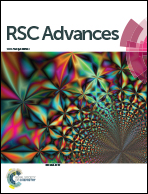Controlled aggregation of quantum dot dispersions by added amine bilinkers and effects on hybrid polymer film properties†
Abstract
Blends of conjugated polymers with semiconducting nanocrystals (NCs) have attracted much interest as photoactive layers for hybrid polymer solar cells. However, uncontrolled aggregation of the NCs within the hybrid films remains a major processing challenge that adversely affects hybrid film properties and device performance. Here, we deliberately triggered the aggregation of dispersed NCs prior to hybrid polymer film formation and studied aggregation effects on film morphology, thickness and absorbance. The aggregation of parent ZnO and PbS dispersions was triggered by addition of 1,2-ethylenediamine. The latter bilinker is more user-friendly than 1,2-ethanedithiol, which is widely used for NC-based solar cells. The extent of NC aggregation was controlled in this study by the bilinker concentration and mixing time prior to spin coating. The effects of ZnO aggregation on poly(3-hexylthiophene) (P3HT)/ZnO hybrid film morphologies were studied using AFM and SEM. The light absorption and emission properties were probed using UV-visible and photoluminescence spectroscopy. We found that P3HT/ZnO film thickness and absorbance both increased as ZnO aggregation became more pronounced. The results of this study imply that NC aggregation during hybrid polymer solar cell construction may increase light absorption due to increased film thickness. The implications of these effects for hybrid solar cell device optimisation studies are discussed.


 Please wait while we load your content...
Please wait while we load your content...